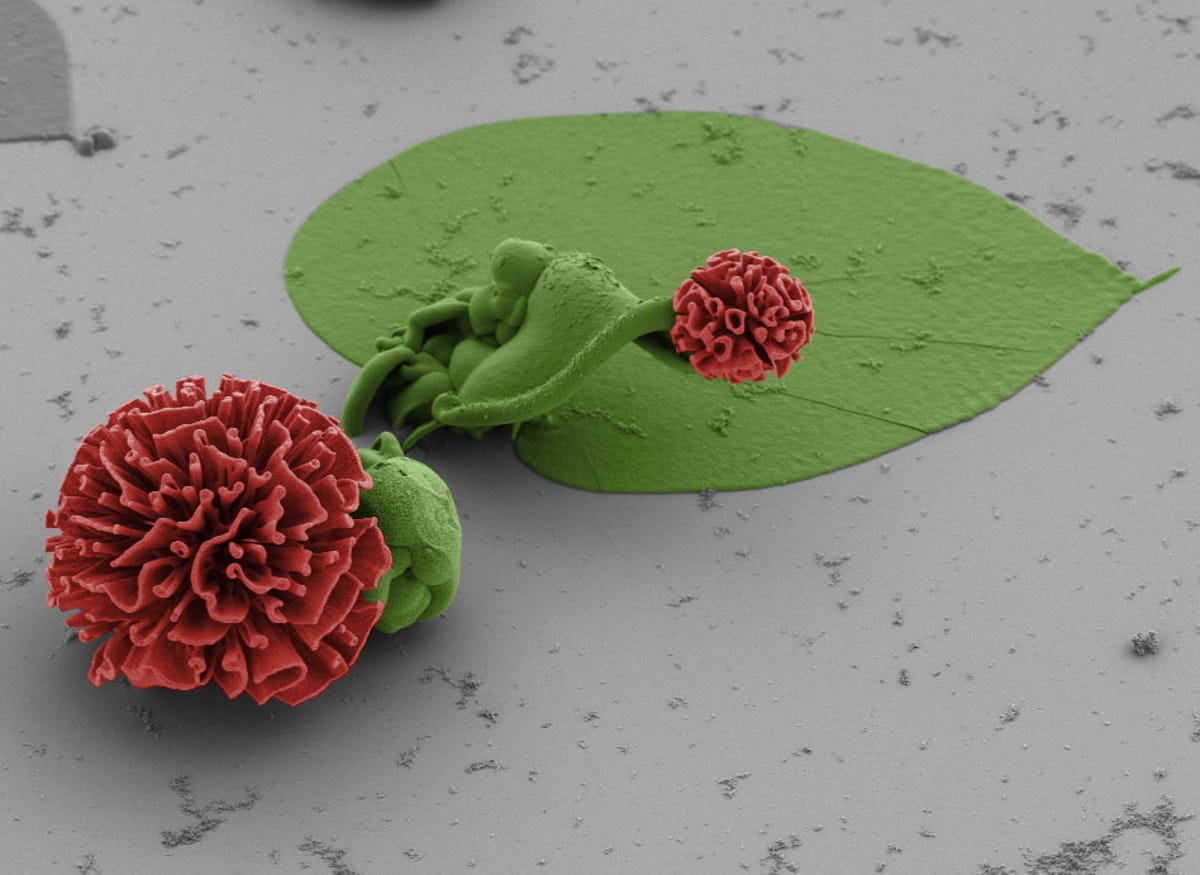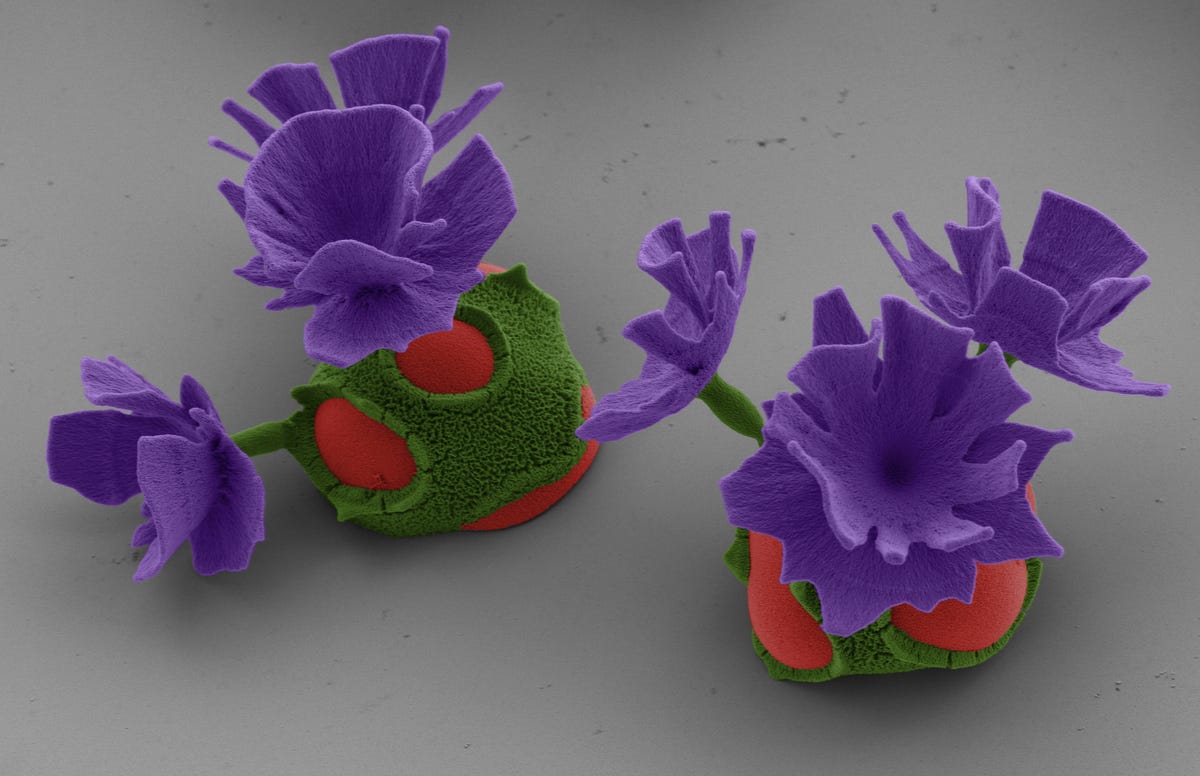A flower garden invisible to the naked eye (pictures)
Wim Noorduin is creating stunning fields of flowers and gardens of coral structures. But you'll need a microscope to see these nano-wonders.

A peony perhaps?
Harvard University postdoctoral research fellow Wim Noorduin creates gorgeous microscopic worlds by combining barium carbonate and sodium silicate in a beaker and then manipulating the chemical and atmospheric conditions to get crystalline structures that look precisely the way he wants them to.
The primary way in which the structures take shape, Noorduin told Crave, has to do with the levels of chemicals in the water, which influence "if structures either grow away from one other to form stems, vases, and corals, or grow towards one other and curl up in all kinds of spiraling shapes."
See related article: Sculpting flowers smaller than a human hair
Flowers in an electron microscope field
Noorduin's sensitive structures can be further controlled by manipulating factors such as the temperature or acidity of the water as they grow. "Just taking off the lid of the beaker (which allows more CO2to enter it), adding a drop of acid, or mixing in some kitchen salt, can already give completely different shapes," he told Crave. "We can apply these modulations continuously while the structures are growing so that you can, for instance, make precise patterns."
See related article: Sculpting flowers smaller than a human hair
Tiny tulips
To create structures with different components, Noorduin says he first grows a structure, like a stem, and then places it in a new solution to get a different structure -- like petals -- to attach to it. "This new solution can contain completely different chemical conditions such that we can radically change the shape and at the same time control where we grow the new structure," he told Crave. "As a result we can, for instance, first grow a vase and subsequently place a stem inside this vase and open it into a flower so that you make a micro bouquet."
See related article: Sculpting flowers smaller than a human hair
A rose by any other size
When the super-small structures are first created, they are made with colorless materials, according to Noorduin. "We can, however, make colored structures by adding dye molecules to the reaction solution that get built into the structure while they grow," he explained. By switching solutions several times, he can dye different parts of the structure different colors -- red petals on a green stem, for example.
See related article: Sculpting flowers smaller than a human hair
Black, white, and brainlike
When creating the images of his microarchitecture, Noorduin uses electron microscopy, which only produces black and white images. To get the images looking like the actual structures, he colors them after they are taken, mimicking the dyeing process that happens in the crystals at the nanoscale.
See related article: Sculpting flowers smaller than a human hair
Alien violets
"For three years now, I've been looking at these very strange white stripes on plates that are maybe only an inch long or so," Noorduin told The Creators Project, which made a documentary about his work. "And every time I'm amazed that it's a complete sort of coral reef that you're diving into as soon as you look under the microscope," he said. "I notice quite often that I simply forget to make photos because I just want to look further (at) the samples and discover new structures and then get lost. These small samples really contain their own world."
Fortunately for us, he does remember to snap a photo every now and then!
See related article: Sculpting flowers smaller than a human hair
Are these from 'Avatar'?
This might look like a field of flowers -- perhaps a kind familiar to the Na'vi in "Avatar" -- growing on a tabletop, but in reality the structures could fit inside the width of a human hair.
See related article: Sculpting flowers smaller than a human hair
How does your garden grow?
The Creators Project also spoke to Harvard chemistry professor Joanna Aizenberg, in whose group Noorduin works. Of Noorduin's work she said, "Basic science is critical. We do need to understand how and why things assemble. How and why the emergence of form leads to certain structures. Without this basic understanding, we won't be ever able to professionally design the structures, materials, and complex systems that we can use in the future devices."
See related article: Sculpting flowers smaller than a human hair

Very strange
About the reaction to his work, Noorduin told The Creators Project: "The feedback is very broad. Of course, there are many scientists that find this work interesting, but also just people from all over the world who are intrigued by the shapes; especially when you consider that these images were for about three years only on my computer, and then suddenly in one day they are all over the Internet -- that is very strange to me."
See related article: Sculpting flowers smaller than a human hair

